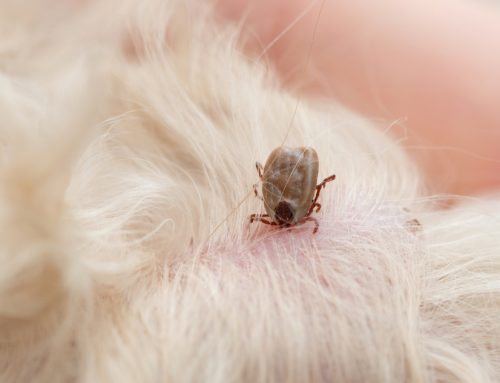An 8-year-old dog who has eaten a chicken-based food their entire life is now licking excessively at their paws and developing recurring ear infections.
A long-haired cat is missing substantial amounts of fur on their hind end and tail, and you can feel tiny scabs on their cheeks, neck, ears, and tail base when you pet them.
A 2-year-old dog’s skin is bright red, especially on their abdomen. They also are chewing obsessively at their paws and rubbing their entire body against any scratchy surface.
These three pets sound like hot messes, right? And, they all have more than skin that feels on fire. Pets with such skin issues have allergies, which can be caused by a wide range of triggers. A great deal of confusion surrounds allergies in pets, and our Hearthstone Veterinary team wants to set the stories straight.
Question: What are the most common pet allergy types?
Answer: Generally, allergies in pets are labeled environmental, flea bite, or food allergies. Some unfortunate pets may have all three allergy types.
- Environmental allergies — These can be triggered in pets through contact with an irritating substance or by inhaling the allergen. Common environmental allergens include:
- Pollen from grass, trees, flowers, and other plants
- Dust mites
- Mold
- Dander
Environmental allergies in pets can be present year-round, or may crop up during the pet’s “itchy season” (e.g., the spring growing season).
- Flea bite allergies — Flea allergies are exactly as they sound—a hypersensitivity to flea bites. Pets with a flea bite allergy are sensitive to a protein found in flea saliva, so only a few bites can spell serious itchy trouble. Since fleas can be a year-round problem, keeping allergic pets on a quality flea prevention protocol is essential for their comfort.
- Food allergies — These are by far the least common type of pet allergy. Additionally, pets are rarely allergic to the grain in their diet, and instead are more sensitive to the protein source. The most common food allergens for pets include:
- Chicken
- Beef
- Lamb
- Dairy
- Fish
- Soy
- Wheat
Typically, pets who are fed the same protein for a long time can become allergic to that food. So, if your cat has always eaten a fish-based diet, they may suddenly become allergic to the fish. However, this does not mean that you should frequently switch your pet’s food, because that can cause gastrointestinal upset, and make correctly diagnosing a food allergy more challenging.
Q: What do allergies look like in pets?
A: People with allergies typically sneeze, have sinus congestion, and itchy, watery eyes. Pets with allergies usually do not have these signs, but rather they develop skin issues. If your pet has allergies, you may notice:
- Itchy, irritated, inflamed skin
- Ear infections
- Hot spots
- Licking and chewing at the paws
- Head shaking
- Tail chewing
- Hair loss
- An odor to the skin, ears, or paws
- Anal gland issues, such as scooting along the floor because of impacted anal glands
Allergy signs can seemingly pop up overnight, so your allergic pet must be closely monitored for flare-ups during their allergy season.
Q: How are allergies diagnosed in pets?
A: Your pet can easily be diagnosed with a flea bite allergy by the live fleas or flea dirt (i.e., the excrement fleas leave behind) on their body. Diagnosing environmental allergies requires a blood or intradermal skin test to determine the local substances that cause your pet’s reaction. While diagnosing these two allergy types is relatively straightforward, food allergies, however, are trickier and require a strict six- to eight-week food trial where your pet eats only a novel protein, hypoallergenic, or prescription hydrolyzed diet. At the end of the food trial, a suspected allergenic protein (e.g., chicken) is reintroduced to the pet and, if they react, a chicken allergy is diagnosed. However, if the pet has been fed different types of food over the course of their lifetime, a food trial will need to be repeated for each protein type.
Q: How are allergies treated in pets?

A: Depending on your pet’s allergy type, treatment may vary, although allergy treatments generally include:
- Corticosteroids
- Anti-itch medications (i.e., Apoquel and Cytopoint)
- Immunotherapy
- Skin supplements
- Medicated shampoos
- Ear cleaners and medications
- Parasite prevention
- Prescription diet
Over time, your pet’s allergies will likely change, and their treatment plan will need adjusting.
If your pet has become a hot mess with the advent of spring’s growing season, they may have developed seasonal allergies to the pollen in the environment, or become allergic to other substances. Contact our Hearthstone Veterinary Hospital team to schedule an appointment to determine the cause of your pet’s itching.







Leave A Comment